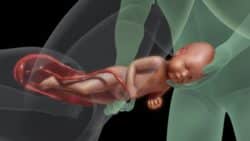VAGINAL BIRTH AFTER CESAREAN SECTION (VBAC), James Miller, MD (Digital)

Many women who have experienced a cesarean section wonder whether they should attempt a vaginal birth in a subsequent pregnancy. Making this decision is not easy and should consider the risks and benefits of VBAC, the reasons for a prior cesarean section, and future family planning.
What are the risks of attempting vaginal birth after a cesarean section?
The major risk associated with VBAC is rupture of the uterus. In simple terms, the uterine organ containing the baby and placenta breaks open and spills amniotic fluid and blood into the belly of the mother. A uterine rupture is an absolute emergency and can be fatal if not treated by immediate cesarean section. Fortunately, a uterine rupture is NOT common. The chance that a uterine rupture occurs after a cesarean section is less than 1%. When a uterine rupture does occur, approximately 10% of babies will either not survive or will suffer permanent brain damage. Therefore, ~1 out of 1000 attempted VBACs will result in catastrophic outcomes for the pregnancy. Risks to the mother include major bleeding, damage to surrounding organs, and potential loss of the uterus (hysterectomy). Appropriate treatments for the mother may include blood transfusions, complex surgery, and a prolonged recovery.
What are the benefits of vaginal birth after a cesarean section?
The benefits of vaginal birth after a cesarean section include faster recovery, shorter hospital stay, reduced risk of infection, and avoidance of major abdominal surgery (and associated risks of surgery). Many women also express a deep psychological, physical, and emotional satisfaction with vaginal birth.
How do I decide?
The risks and benefits of VBAC are not the only things to consider. It is also important to know the reason why a C-section occurred in the prior pregnancy. The reason for a prior C-section will help to predict the chance of a successful vaginal birth. For example, a C-section performed because the baby was breech is associated with a 60-80% chance of successful VBAC. In contrast, a C-section performed after a long time pushing is associated with much lower success rates for a vaginal birth.
One final consideration is future family planning. A woman who desires many more children often is more motivated for VBAC to avoid having multiple cesarean sections.
The Dilemma
In terms of outcomes, the best outcomes generally are from successful VBAC, the worst outcomes are from failed attempts at VBAC (ending up in c-section), and a scheduled c-section is somewhere in between. Unfortunately, no one can predict the future. We, as your doctors, will evaluate your unique pregnancy history and ask you about your hopes and goals for the pregnancy to give you the best possible advice to help you make a well-informed decision.
Learn More on Healthful Woman
Maternal Fetal Medicine blogs are intended for educational purposes only and do not replace certified professional care. Medical conditions vary and change frequently. Please ask your doctor any questions you may have regarding your condition to receive a proper diagnosis or risk analysis. Thank you!







